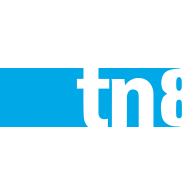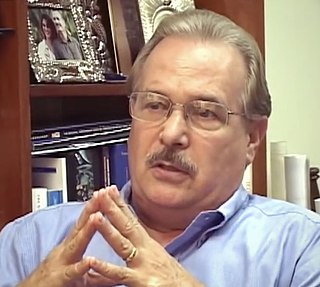
Nicaragua, officially the Republic of Nicaragua, is the largest country in the Central American isthmus, bordered by Honduras to the northwest, the Caribbean to the east, Costa Rica to the south, and the Pacific Ocean to the southwest. Managua is the country's capital and largest city. As of 2015, it was estimated to be the second largest city in Central America. The multi-ethnic population of six million includes people of mestizo, indigenous, European and African heritage. The main language is Spanish. Indigenous tribes on the Mosquito Coast speak their own languages and English.

The Sandinista National Liberation Front is a socialist political party in Nicaragua. Its members are called Sandinistas[sandiˈnistas] in both English and Spanish. The party is named after Augusto César Sandino, who led the Nicaraguan resistance against the United States occupation of Nicaragua in the 1930s.
La Prensa is a Nicaraguan newspaper, with offices in the capital Managua. Its current daily circulation is placed at 42,000. Founded in 1926, in 1932 it was bought by Pedro Joaquín Chamorro Zelaya, who had become editor-in-chief. He promoted the Conservative Party of Nicaragua and became a voice of opposition to Juan Bautista Sacasa, for which the paper was censored. He continued to be critical of dictator Anastasio Somoza García, who came to power in a coup d'etat.

Rigoberto López Pérez was a Nicaraguan poet, artist and composer. He assassinated Anastasio Somoza García, the longtime dictator of Nicaragua.

General elections were held in Nicaragua on 5 November 2006. The country's voters went to the polls to elect a new President of the Republic and 90 members of the National Assembly, all of whom will serve five-year terms. Daniel Ortega (FSLN) won the race with 37.99% of the vote, Eduardo Montealegre (ALN) trailing with 28.30%, José Rizo (PLC) with 27.1%, Edmundo Jarquín (MRS) with 6.29%, and Edén Pastora (AC) with just 0.29%.

Tomás Borge Martínez, often spelled as Thomas Borge in United States newspapers) was a cofounder of the Sandinista National Liberation Front in Nicaragua and was Interior Minister of Nicaragua during one of the administrations of Daniel Ortega. He was also a renowned statesman, writer, and politician. Tomás Borge also held the titles of "Vice-Secretary and President of the FSLN", member of the Nicaraguan Parliament and National Congress, and Ambassador to Peru. Considered a hardliner, he led the "prolonged people's war" tendency within the FSLN until his death.

Canal 2 is a Nicaraguan free-to-air television network owned by Televicentro de Nicaragua, S.A.

Canal 4 is a state-run nationwide terrestrial television channel in Nicaragua owned by Informativos de Televisión y Radio S.A. (Intrasa), a company owned by two sons of Daniel Ortega, Carlos Enrique "Tino" Ortega and his brother Daniel Edmundo. Until 2007, Remigio Ángel González of Albavisión owned 94% of the channel's assets, after that, the Ortega-Murillo regained control.

Telenica is a nationwide state-run terrestrial television channel from Nicaragua, founded by Nicaraguan businessman Carlos Briceño in 1992. The channel was bought by Juan Carlos Ortega in late 2009, yet it was not made public until January 2010, the change in ownership led to a change in profile. TN8 is one of Nicaragua's main channels.

Joaquín Cuadra Lacayo, a scion of Nicaragua's elite, joined the rebel Sandinista National Liberation Front (FSLN) in late 1972. After their victory in 1979, he became army chief of staff.
The mass media in Nicaragua consist of several different types of communications media: television, radio, cinema, newspapers, magazines, and Internet-based Web sites.

Rosario María Murillo Zambrana is the vice president and first lady of Nicaragua. She got married to the current president Daniel Ortega. Murillo has served as the Nicaraguan government's lead spokesperson, government minister, head of the Sandinista Association of Cultural Workers, and Communications Coordinator of the Council on Communication and Citizenry. She was sworn in as vice president of Nicaragua on 10 January 2017. In August 2021, she was made subject to personal sanctions by the European Union, over alleged human rights violations.
Confidencial is a Nicaraguan weekly newspaper in Nicaragua with offices in the capital Managua. It was founded in 1996 by Carlos Fernando Chamorro Barrios, Chamorro is the former director of the Sandinista National Liberation Front newspaper Barricada and son of Pedro Joaquín Chamorro Cardenal, Nicaraguan journalist and former editor of La Prensa who was murdered in the last year of the Somoza rule, influencing public sympathy for the FSLN rebels.

Sofía Montenegro Alarcón is a Nicaraguan journalist, social researcher, and feminist. Montenegro's family were militarily aligned with the Somoza forces, but her feminist and Marxist studies moved her to join with the opposition to the regime. She fought in the Sandinista Revolution and though initially supportive of the Sandinista Party, later became an outspoken critic, saying it had moved to the right. She served as an editor of various divisions of the official Sandinista newspaper, Barricada, until 1994, when she founded the Center for Communication Research (CINCO) as an independent research organization free of government influence. She has written broadly on power, gender, and social interaction.
Silvio Enrique Conrado Gómez was the Nicaraguan director of the Central American Bank for Economic Integration (BCIE) serving from 2002 until his death. He was an economist. In 2007, he was a member of the Special Commission for the Promotion of Investments (Pro-Nicaragua). He was widely regarded as the key individual in the management of the financial resources and the macroeconomic stability of Nicaragua. Since 2002, he was also a director of the Central Bank of Nicaragua, and served a term as its president from 2006 to 2010.

The 2018–2022 Nicaraguan protests began on 18 April 2018 when demonstrators in several cities of Nicaragua began protests against the social security reforms decreed by President Daniel Ortega that increased taxes and decreased benefits. After five days of unrest in which nearly thirty people were killed, Ortega announced the cancellation of the reforms; however, the opposition has grown through the 2014–2018 Nicaraguan protests to denounce Ortega and demand his resignation, becoming one of the largest protests in his government's history and the deadliest civil conflict since the end of the Nicaraguan Revolution. On 29 September 2018, political demonstrations were declared illegal by President Ortega. More than 2,000 protests were part of this significant mobilization.

The 2018–2020 Nicaraguan protests began on 18 April 2018 following a move by the government of Daniel Ortega to reform social security. Following the deaths of protesters, demonstrations intensified and grew into a large anti-Ortega movement seeking his removal from office.

Reyna Rueda Alvarado is a Nicaraguan politician. A member of the Sandinista National Liberation Front (FSLN), she has served as mayor of Managua since 2018.

Mauricio Herdocia Sacasa was a Nicaraguan jurist who specialized in international law, and diplomat. He held roles in the Nicaraguan government, especially in the Foreign Ministry, across party lines, as well as roles in major international legal bodies including at the United Nations and the Organization of American States. In the 1980s, he worked on a number of peace processes in Central America, helping formalize legal and political structures for the region. Also a legal scholar and professor, he was rector of the American College University and the author of four books on the laws governing the sovereignty and territorial integrity of Nicaragua. His contributions were recognized with a number of honors both nationally and internationally, including Nicaragua's Order of Rubén Darío.
Pedro Joaquín Chamorro Barrios is a Nicaraguan journalist and politician. He began his career in journalism working at La Prensa, following the 1978 assassination of its editor, his father, Pedro Joaquín Chamorro Cardenal. Working on the side of the Contras in exile in the 1980s, he returned to the country in 1989 when his mother Violeta Barrios de Chamorro ran for president, and following her election, served as a Nicaraguan ambassador. He later became defense minister. In the 21st century, Chamorro has been a city councilor for Managua and deputy in the National Assembly, also for Managua. On 25 June 2021, he became part of a wave of arrests of opposition and civic figures in Nicaragua.















